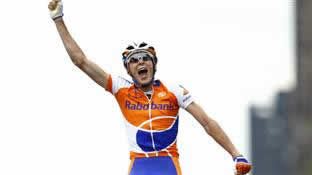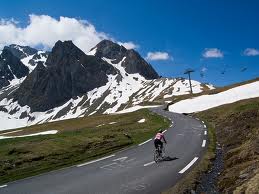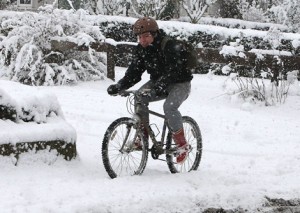Cycle Training Tips
 Set Up
Set Up
Riding a bike that is not correctly set up for you will cause discomfort and even slow you down. Everyone is different with respect to leg, arm and torso length, so visiting a specialist bike shop and having your saddle, stem and handlebar positions adjusted so that the bike is tailored to your individual needs is extremely worthwhile.
Essential Kit
A small investment in a few items of specialist bike kit will be extremely useful for you to get the most out of your training. The minimum items are:
- Bike helmet. An absolute must. Modern cycling helmets are lightweight and well ventilated, and can literally save your life in an accident. We have all come off our bikes at some point so protecting your head should be your top priority.
- Cycling shorts. Seamless and chafe-free. Proper cycling shorts may not directly improve your training but they will add to the enjoyment of your ride by preventing soreness from repeated rubbing and should be a key item in your cycling wardrobe.
- Basic bike tools. A set of Allen keys, a puncture repair kit, tire levers, a spare inner tube and a pump will keep you on the road. All you need to know is how to change a tire and mend a puncture and you’re set up.
- Cycling sunglasses. Sunglasses are actually very useful for cyclists and not just for posing. They will keep dirt, dust and flies out of your eyes, and if you choose a pair with interchangeable lenses then they can sharpen your vision in low light conditions, as well as cutting out glare and reflections.
- Toe-clips or spuds. SPDs or ‘spuds’, as they are affectionately known — is the name for cycling shoes which lock into your pedal. They make a big difference to your pedaling efficiency because they enable you to pull up as well as push down. If you’ve not tried them before they will take a bit of getting used to but after a while you’ll wonder how you ever managed without them!
Keep Hydrated
When cycling your body will lose water through sweating as well as losses from exhaled will result in your heart having to work much harder. Try to drink small, frequent quantities of water or a sports energy drink throughout your ride rather than waiting till you feel thirsty as by the time you feel thirsty you will already be dehydrated.
Energy
Running low on energy will prevent your cycling enjoyment. Cycling will increase your energy requirements so aim to eat small, frequent meals and snacks on the go in order to maintain energy levels. Whilst your riding carbohydrate drinks will keep you well fuelled or you could try a couple of energy bars which are easy to eat in the saddle.
 Long Rides
Long Rides
An important part of your cycling training should be the long ride. Aim to do a long ride every one or two weeks. The long ride will build your endurance and also make you more efficient at utilizing fuel. A ‘Long’ ride will be anything longer than your usual routine. Anything from around one hour and beyond will do but obviously this should be adjusted to take into account your fitness as well as your training goals. A long ride is also a great opportunity to explore new areas and visit new destinations.
Interval Training
To balance out your long ride, try experimenting with some faster-paced riding. Sessions can be infinitely varied, but basically you are looking to ride faster for a short period, for example 10 minutes, followed by a recovery period and then a couple of repeats of the faster effort. Always include a good warm-up and cool-down before and after your session.
Bad Weather
Sometimes the weather is bad, it’s dark, or perhaps you just don’t fancy an outdoor bike session. However, there is no need to let your training slip because there are several alternatives available:
 Gym bikes. Never as good as the real thing, but as a substitute stationary gym bikes can still give you a decent workout. Most have a variety of programs to simulate hill climbing or interval training and are a good alternative if you can’t get out on the road.
Gym bikes. Never as good as the real thing, but as a substitute stationary gym bikes can still give you a decent workout. Most have a variety of programs to simulate hill climbing or interval training and are a good alternative if you can’t get out on the road.
- Cycle trainers. A device that attaches to the back wheel of your own bike and enables you to train at home. Your bike is supported in a stand and most trainers have a variable resistance.
- Rollers. Also for home use, rollers don’t support you so there is the additional challenge of balancing during your training session — just as you would outdoors.
- Spinning classes. A dynamic, group-based stationary bike spinning workout that is usually challenging but enjoyable and provides excellent training. One 60 minute session each week will definitely improve your cycling fitness.
By starting out with a correctly set up bike, a few items of kit, a fuelled stomach and full fluid bottle, your training will be more enjoyable. There is nothing worse than a long ride when you’re on an uncomfortable bike, when you’re hungry or when you’re wearing unsuitable clothing! Simply follow the tips above and you’re guaranteed to get more out of your cycling. You’ll be whizzing past the stationary motorists even faster! Enjoy your cycling!





